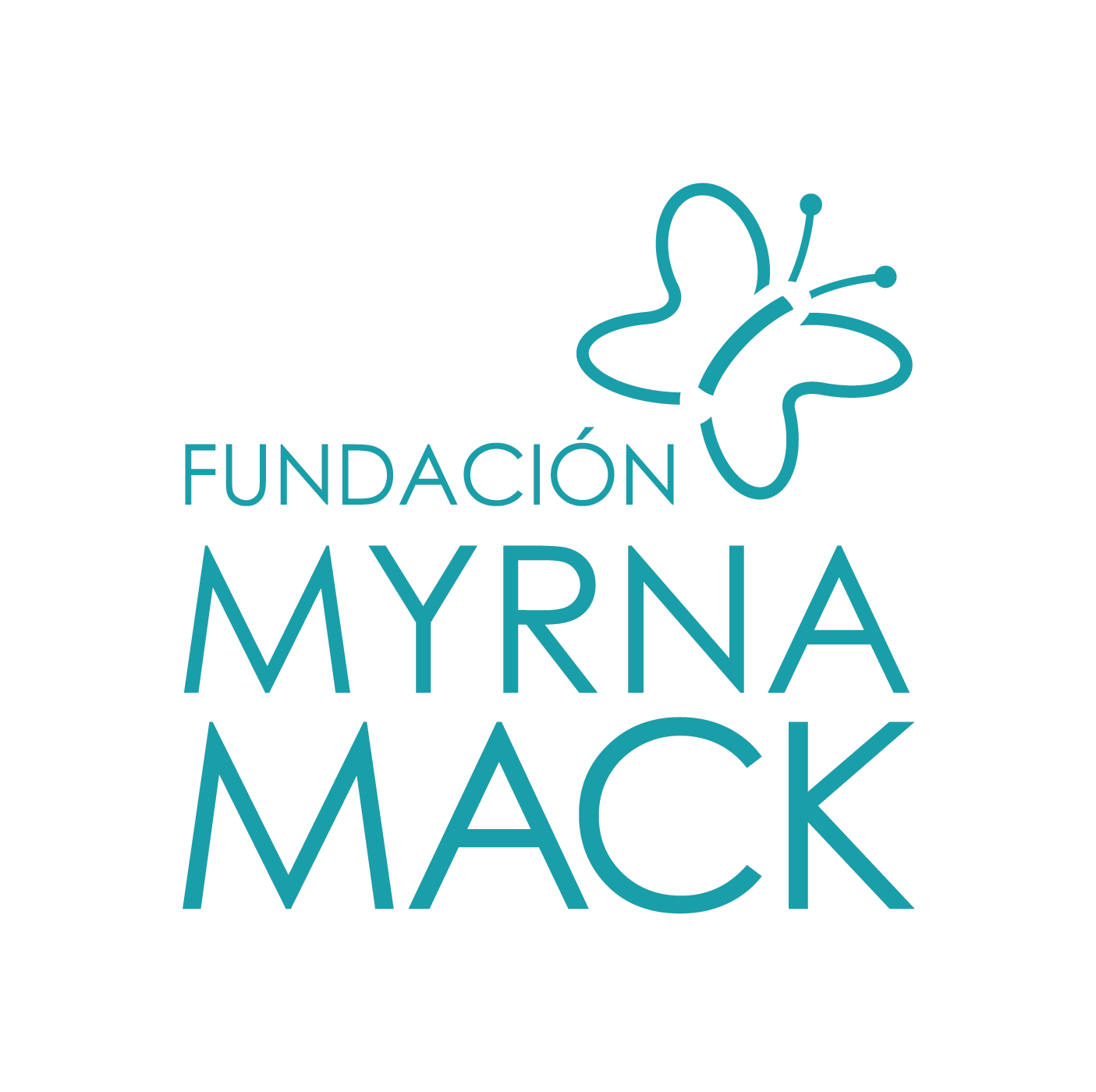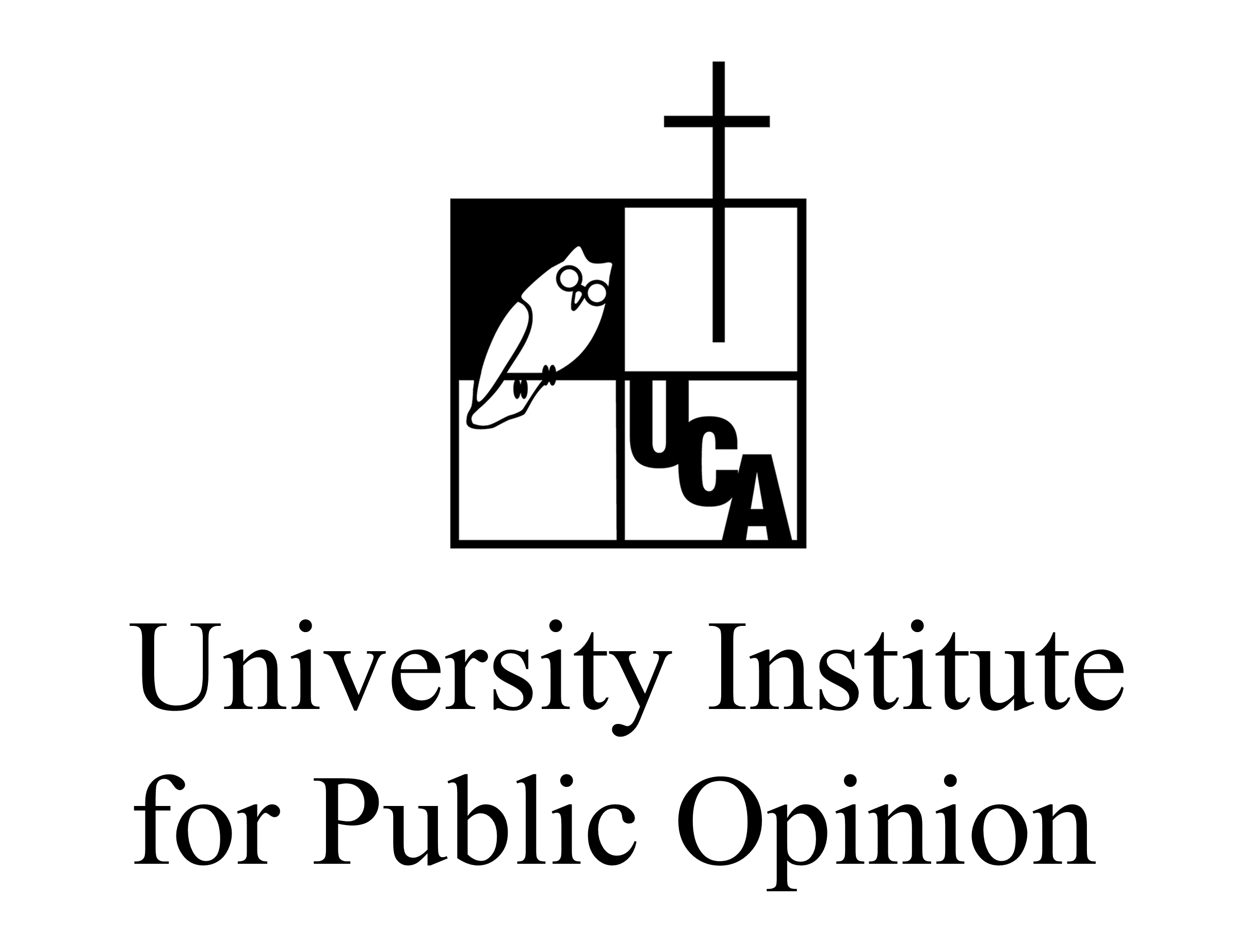Strengthening of Civilian Police Forces
CENTRAL AMERICA MONITOR:
EVALUATING PROGRESS
Central America’s Northern Triangle region is struggling with violence, corruption and impunity.
Scroll for the key findings or to find links to download the full reports under each area of progress.
Evaluating progress in Central America
As Guatemala, El Salvador, and Honduras struggle with high levels of violence and insecurity, systemic corruption, and widespread impunity, it’s critical that we find ways to assess how the policies and strategies being implemented in the region are contributing to the strengthening of the rule of law, improving transparency and accountability, and to reducing violence and insecurity. Using a comprehensive series of indicators, the Central American Monitor aims to measure progress and identify trends over time in eight key areas directly relevant to rule of law and security, thus providing critical information that can inform policies and strategic investments in the region.
The Washington Office on Latin America (WOLA), the Myrna Mack Foundation (FMM) of Guatemala, the University Institute for Public Opinion (Iudop) of the José Simeón Cañas Central American University (UCA) of El Salvador, the University Institute on Democracy, Peace and Security (IUDPAS) of the National Autonomous University of Honduras (UNAH) have developed a series of qualitative and quantitative indicators to evaluate progress in Central America in eight key areas.
Strengthening of Civilian Police Forces
Areas of progress
1.
Functioning of Police Career Systems
Since its creation in 1998, elements of military doctrine have persisted in the nature, formation, and operations of the Honduran National Police (PNH). Reform efforts have emphasized the need to strengthen the institution’s status as a civilian force. However, the executive branch has pushed to re-militarize public security, indicative of how militarized security policy continues to hold force in Honduran politics.
The PNH faces a crisis of legitimacy and citizen trust. In addition to the accusations leveled against the institution, its repressive manner of handling social conflicts led 72%of survey respondents to distrust the PNH and 53.0% to say they were afraid of it in a 2014 survey. In 2016, 58.6% of survey respondents said they distrusted the police. Of all the institutions in the country’s security and justice sector, only the Public Prosecutor’s Office, the Judiciary, the Office of the President, and the National Congress have a lower confidence rating than the PNH.
In 2017, the government approved a new Organic Law of the National Police and Police Career Law. While they do have limitations, these new laws lay the foundations for modernizing the institution’s structure and developing a training, career and merit-based promotion system.
While there has been growth in the size of the police force, the Honduran National Police remains well below minimum international standards recommended for national coverage. The United Nations Office on Drugs and Crime (UNODC) recommends countries have a minimum average of 300 police officers per 100,000 people. In 2014, the average number of police officers per 100,000 people in Honduras was 149; 141 in 2015; 157 in 2016; and 169 in 2017. With regard to the UNODC minimum, the PNH fell 14,604 officers short of this recommendation in 2017. The police force has gradually gained a greater proportion of women, reaching 20% of all personnel. During the period covered by this report, 24% of new members of the police were women. They also made up 10% of the graduates from the Honduras National Police University (UNPH).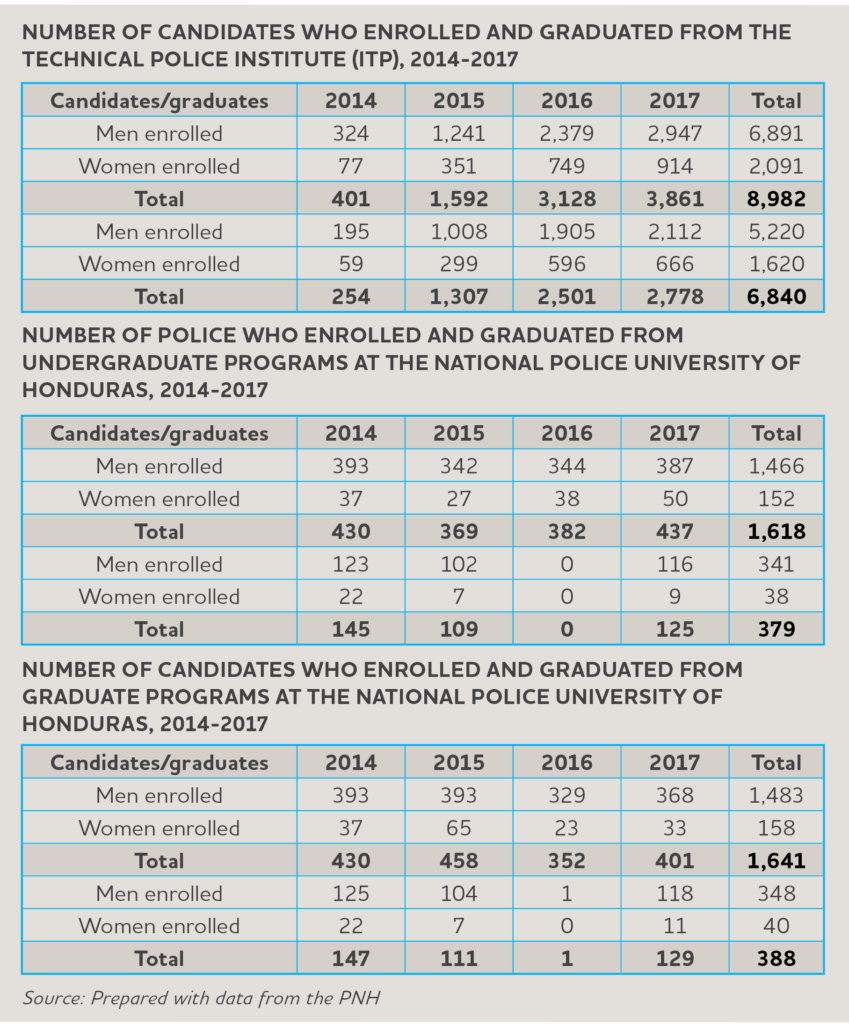 Between 2014 and 2017, the country witnessed a notable process of “privatization” of public safety responsibilities. In 2017, there were 7 private security agents for every 1 police officer. There has been a rapid increase in private security companies: in 2013, approximately 700 companies were registered, a number which swelled to 1,038 in 2017. This trend demonstrates gaps in public safety efforts as the National Police fills other functions, as well as the economic profitability that the private sector finds in the public security sector.
Between 2014 and 2017, the country witnessed a notable process of “privatization” of public safety responsibilities. In 2017, there were 7 private security agents for every 1 police officer. There has been a rapid increase in private security companies: in 2013, approximately 700 companies were registered, a number which swelled to 1,038 in 2017. This trend demonstrates gaps in public safety efforts as the National Police fills other functions, as well as the economic profitability that the private sector finds in the public security sector.
Since 2000, there have been various attempts to reform the National Police and address the problems of abuse and corruption within the institution. In 2012, the government created the Commission for Public Security Reform (CRSP), made up of national and international representatives tasked with proposing comprehensive reforms to security and justice institutions. After presenting various reforms, which failed to advance due to lack of congressional support, the CRSP ceased operating in 2014. As part of this effort, the government created the Directorate for Investigation and Evaluation of the Police Career (DIECP). However, the DIECP faced criticism for failure to deliver results, and the government dissolved the agency in 2015. From 2012 to 2015, the DIECP had evaluated 8,546 police and removed only 227, all of whom were low-ranking individuals. In 2016, the government formed a Special Commission to Purge and Transform the Honduran National Police. By April 2018, it had removed 4,365 police officers.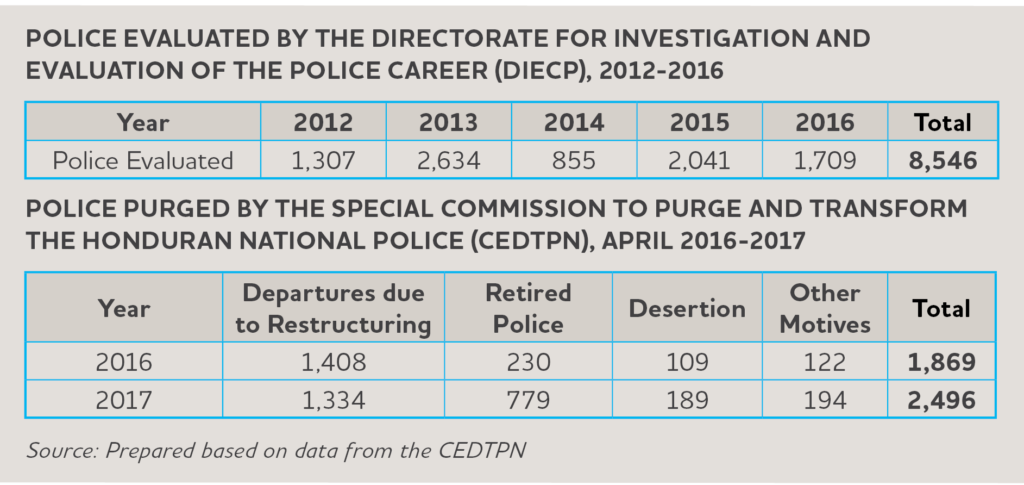
The PNH faces a crisis of legitimacy and citizen trust. In addition to the accusations leveled against the institution, its repressive manner of handling social conflicts led 72%of survey respondents to distrust the PNH and 53.0% to say they were afraid of it in a 2014 survey. In 2016, 58.6% of survey respondents said they distrusted the police. Of all the institutions in the country’s security and justice sector, only the Public Prosecutor’s Office, the Judiciary, the Office of the President, and the National Congress have a lower confidence rating than the PNH.
In 2017, the government approved a new Organic Law of the National Police and Police Career Law. While they do have limitations, these new laws lay the foundations for modernizing the institution’s structure and developing a training, career and merit-based promotion system.
While there has been growth in the size of the police force, the Honduran National Police remains well below minimum international standards recommended for national coverage. The United Nations Office on Drugs and Crime (UNODC) recommends countries have a minimum average of 300 police officers per 100,000 people. In 2014, the average number of police officers per 100,000 people in Honduras was 149; 141 in 2015; 157 in 2016; and 169 in 2017. With regard to the UNODC minimum, the PNH fell 14,604 officers short of this recommendation in 2017. The police force has gradually gained a greater proportion of women, reaching 20% of all personnel. During the period covered by this report, 24% of new members of the police were women. They also made up 10% of the graduates from the Honduras National Police University (UNPH).
 Between 2014 and 2017, the country witnessed a notable process of “privatization” of public safety responsibilities. In 2017, there were 7 private security agents for every 1 police officer. There has been a rapid increase in private security companies: in 2013, approximately 700 companies were registered, a number which swelled to 1,038 in 2017. This trend demonstrates gaps in public safety efforts as the National Police fills other functions, as well as the economic profitability that the private sector finds in the public security sector.
Between 2014 and 2017, the country witnessed a notable process of “privatization” of public safety responsibilities. In 2017, there were 7 private security agents for every 1 police officer. There has been a rapid increase in private security companies: in 2013, approximately 700 companies were registered, a number which swelled to 1,038 in 2017. This trend demonstrates gaps in public safety efforts as the National Police fills other functions, as well as the economic profitability that the private sector finds in the public security sector.
Since 2000, there have been various attempts to reform the National Police and address the problems of abuse and corruption within the institution. In 2012, the government created the Commission for Public Security Reform (CRSP), made up of national and international representatives tasked with proposing comprehensive reforms to security and justice institutions. After presenting various reforms, which failed to advance due to lack of congressional support, the CRSP ceased operating in 2014. As part of this effort, the government created the Directorate for Investigation and Evaluation of the Police Career (DIECP). However, the DIECP faced criticism for failure to deliver results, and the government dissolved the agency in 2015. From 2012 to 2015, the DIECP had evaluated 8,546 police and removed only 227, all of whom were low-ranking individuals. In 2016, the government formed a Special Commission to Purge and Transform the Honduran National Police. By April 2018, it had removed 4,365 police officers.

Strengthening of Civilian Police Forces
Areas of progress
2.
Allocation and Use of Budgetary Resources
The Ministry of Security received 2.5% of the overall national budget over the four years covered by this report. Its funding increased by 57.5% from 2014 to 2017. However, the trend changed in 2014 with the creation of the Military Police of Public Order (Policía Militar del Orden Público, PMOP), indicative of how the Ministry of Defense became the top priority in public security funding. Of the Ministry of Security's budget, 35.8% was allocated to preventive police services, 30.6% to activities common to all the different police services, 24.7% to investigatory services, 5.3% to traffic policing, and 3.6% to police training. However, in 2017 the funds allocated for investigating crime increased by 283% and for education by 261.5%. Meanwhile, funding for preventive services dropped by 72.6% and traffic policing by 70.5%.
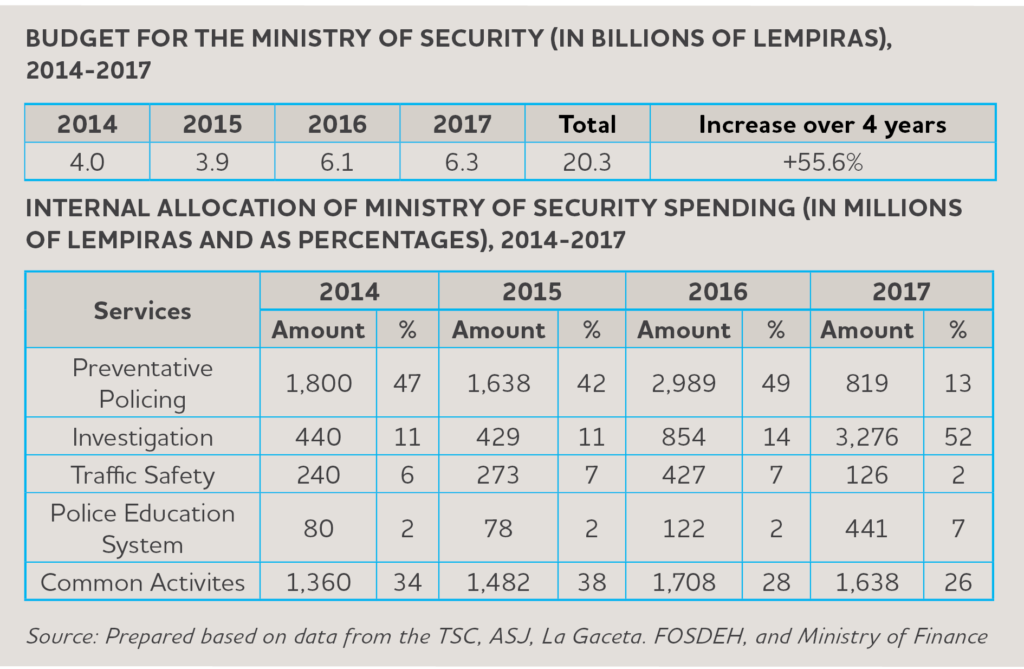

GLOSSARY
The Washington Office on Latin America (WOLA), the Myrna Mack Foundation (FMM) of Guatemala, the University Institute for Public Opinion (Iudop) of the José Simeón Cañas Central American University (UCA) of El Salvador, the University Institute on Democracy, Peace and Security (IUDPAS) of the National Autonomous University of Honduras (UNAH) have developed a series of indicators to assess the progress in Central America in eight key areas. That progress will reflect both the commitment of Central American governments and the effectiveness of international assistance. The indicators include a combination of quantitative data and qualitative analysis in order to gain a more in-depth understanding of the changes taking place in each country. Data sources include official documents and statistics, surveys, interviews, and reviews of existing laws and regulations that will be systematically compiled.
WOLA, the Myrna Mack Foundation, Iudop, and IUDPAS developed these indicators in a months-long process that included review of international standards, consultation with experts, and consensus among all partners about the key issues to address.
Our goal is to provide an instrument that can help identify the areas of progress and opportunities for improvement shortfalls for of the policies and strategies being implemented on the ground in a form that is useful for policymakers, donors, academics, and the public. At the same time, we hope to provide analysis that can contribute to the evaluation of trends over time both within and between the countries of the Northern Triangle.
1
Strengthening the Capacity and Independence of Justice Systems
Capacity of the Justice System: Number of criminal justice officials, geographical coverage, workload, effectiveness, and public trust.
Internal Independence: Existence and implementation of a public, merit-based selection process free from external influence, a results-based evaluation system, and an effective disciplinary system.
External Independence: Size of budget allocated for the judicial sector and implementation of national and international protection measures for justice officials.
2
Cooperation with Anti-Impunity Commissions
Political Will and Level of Collaboration: Commitment of the state to collaborate and enable the work of the CICIG in Guatemala and the MACCIH in Honduras, demonstrated by the progress of emblematic cases, the approval of legislative reforms, and support for domestic counterparts working with these commissions.
3
Combating Corruption
Level of Public Trust: Degree of public trust in state institutions involved in efforts to prevent, identify, investigate, and punish corruption.
Scope and Implementation of Legislation to Combat Corruption: Classification of new crimes in criminal codes and reforms of existing anti-corruption laws to adhere to international standards.
Advancements in Criminal Investigations: Number of corruption cases filed, prosecuted, and resolved, as well as the progress made in emblematic cases.
Functioning of Oversight Bodies: Existence and capacity of external oversight bodies or agencies to combat corruption.
4
Tackling Violence and Organized Crime
Capacity Building: Existence and functioning of specialized anti-organized crime units, application of scientific and technical investigative methods, and functioning of judges or tribunals dedicated to the prosecution of organized crime
Advances in Criminal Investigations: The number of organized crime-related cases filed, prosecuted, and resolved, as well as the progress made in emblematic cases.
Crime Reduction: Convictions for homicides, extortion, and against criminal networks, as well as a reduction in serious and violent crimes.
5
Strengthening Civilian Police Forces
Functioning of Police Career Systems: Existence and effectiveness of police recruitment and promotion mechanisms, training processes, and disciplinary systems, as well as the structure of police bodies.
Allocation and Use of Budgetary Resources: Allocation and effective use of public funds and percentage designated for the wellbeing of members of the civilian police forces.
Community Relations: Public trust in the police, police-community relations, and relations with indigenous authorities.
6
Limiting the Role of the Armed Forces in Public Security Activities
Development and Implementation of a Concrete Plan: The design and implementation of a publicly accessible and verifiable plan with goals, timelines, activities, and clearly established indicators; repeal of legal norms authorizing participation of armed forces in public security, and access to information regarding payroll and assigned resources.
Conduct of Military Forces: Complaints, accusations, and sentences regarding human rights violations perpetrated by members of the armed forces and the level of public trust in the armed forces.
7
Protecting Human Rights
Investigation and Conviction of Human Rights Violations: Existence and functioning of specialized investigative units, number of complaints, prosecutions, and convictions, handling of emblematic cases, and degree of security forces’ collaboration with investigations.
Protection Mechanisms: Structure and functioning of domestic protection mechanisms and implementation of international protection measures for human rights defenders who have been victims of attacks or threats.
Hate Speech: Analysis of attacks and smear or defamation campaigns against human rights defenders.
8
Improving Transparency
Scope and Implementation of the ‘Law of Access to Public Information’: Type of information categorized as restricted or of limited access, period of classification, availability and quality of statistics related to security and justice, information requests granted and denied, and related fees.
Budget and Spending Transparency: Access to public information on budget allocations and spending on security, justice, and defense.
Disclosure of Public Officials’ Statement of Assets: Level of official compliance with disclosure norms, and the degree to which such statements are made available to the public.
METHODOLOGY
The Central America Monitor is based on the premise that accurate, objective, and complete data and information are necessary to reduce the high levels of violence and insecurity, and establish rule of law and governance in a democratic state. This will allow efforts to move beyond abstract discussions of reform to specific measures of change.
The Monitor is based on a series of more than 100 quantitative and qualitative indicators that allow a more profound level of analysis of the successes or setbacks made in eight key areas in each of the three countries. More than a comprehensive list, the indicators seek to identify a way to examine and assess the level of progress of the three countries in strengthening the rule of law and democratic institutions. The indicators seek to identify the main challenges in each of the selected areas and examine how institutions are (or are not) being strengthened over time. The Monitor uses information from different sources, including official documents and statistics, surveys, interviews, information from emblematic cases, and analysis of existing laws and regulations.
The indicators were developed over several months in a process that included an extensive review of international standards and consultation with experts. The eight areas analyzed by the Monitor include:

